lock Alfa Romeo 8C 2010 Owner handbook (in English)
[x] Cancel search | Manufacturer: ALFA ROMEO, Model Year: 2010, Model line: 8C, Model: Alfa Romeo 8C 2010Pages: 223, PDF Size: 14.35 MB
Page 64 of 223
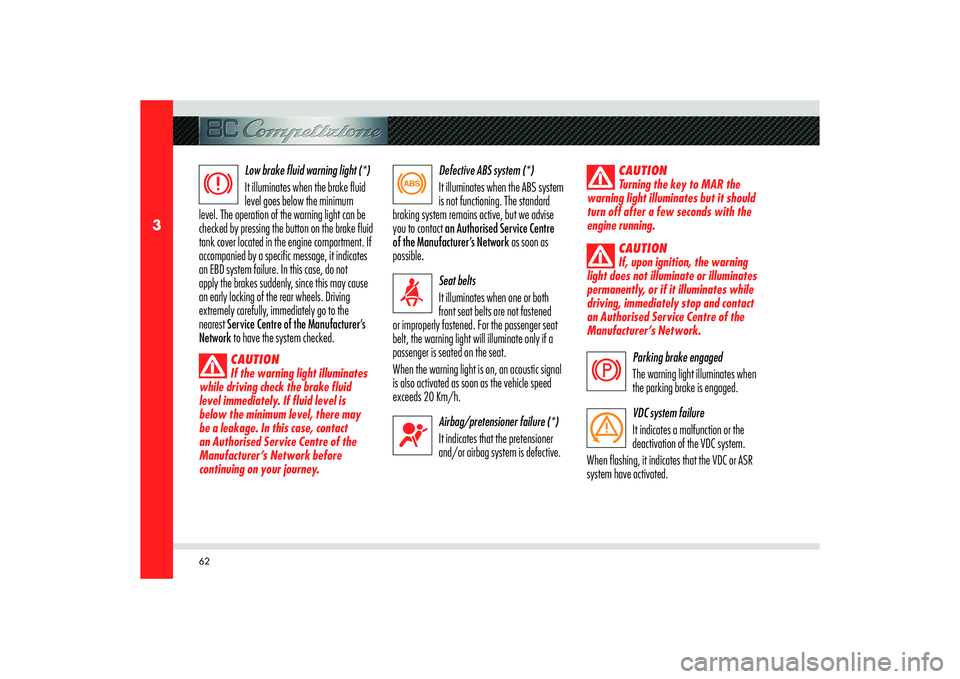
62
3
Low brake fluid warning light (*)
It illuminates when the brake fluid
level goes below the minimum
level. The operation of the warning light can be
checked by pressing the button on the brake fluid
tank cover located in the engine compartment. If
accompanied by a specific message, it indicates
an EBD system failure. In this case, do not
apply the brakes suddenly, since this may cause
an early locking of the rear wheels. Driving
extremely carefully, immediately go to the
nearest Service Centre of the Manufacturer’s
Network to have the system checked.
CAUTION
If the warning light illuminates
while driving check the brake fluid
level immediately. If fluid level is
below the minimum level, there may
be a leakage. In this case, contact
an Authorised Service Centre of the
Manufacturer’s Network before
continuing on your journey.
Defective ABS system (*)
It illuminates when the ABS system
is not functioning. The standard
braking system remains active, but we advise
you to contact an Authorised Service Centre
of the Manufacturer’s Network as soon as
possible.
Seat belts
It illuminates when one or both
front seat belts are not fastened
or improperly fastened. For the passenger seat
belt, the warning light will illuminate only if a
passenger is seated on the seat.
When the warning light is on, an acoustic signal
is also activated as soon as the vehicle speed
exceeds 20 Km/h.
Airbag/pretensioner failure (*)
It indicates that the pretensioner
and/or airbag system is defective.
CAUTION
Turning the key to MAR the
warning light illuminates but it should
turn off after a few seconds with the
engine running.
CAUTION
If, upon ignition, the warning
light does not illuminate or illuminates
permanently, or if it illuminates while
driving, immediately stop and contact
an Authorised Service Centre of the
Manufacturer’s Network.
Parking brake engaged
The warning light illuminates when
the parking brake is engaged.
VDC system failure
It indicates a malfunction or the
deactivation of the VDC system.
When flashing, it indicates that the VDC or ASR
system have activated.
Page 71 of 223
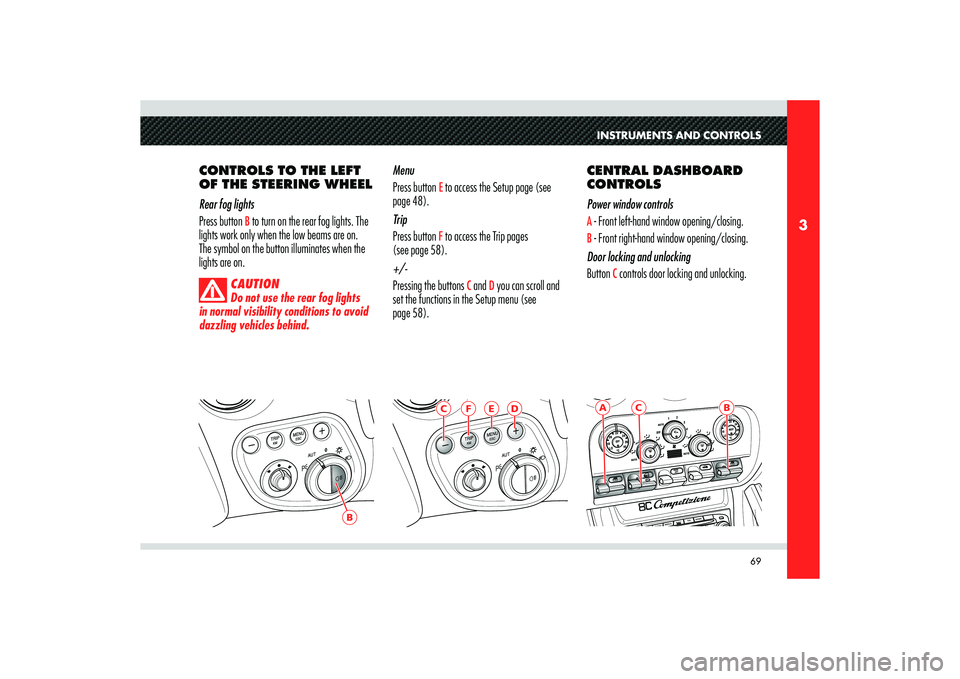
69
3
B
C
B
AINSTRUMENTS AND CONTROLS
CONTROLS TO THE LEFT
OF THE STEERING WHEEL
Rear fog lights
Press button
B to turn on the rear fog lights. The
lights work only when the low beams are on.
The symbol on the button illuminates when the
lights are on.
CAUTION
Do not use the rear fog lights
in normal visibility conditions to avoid
dazzling vehicles behind.
Menu
Press button
E to access the Setup page (see
page 48).
Trip
Press button F to access the Trip pages
(see page 58).
+/-
Pressing the buttons
C and
D you can scroll and
set the functions in the Setup menu (see
page 58).CENTRAL DASHBOARD
CONTROLS
Power window controls
A - Front left-hand window opening/closing.B - Front right-hand window opening/closing.
Door locking and unlocking
Button
C controls door locking and unlocking.
E
F
C
D
Page 72 of 223
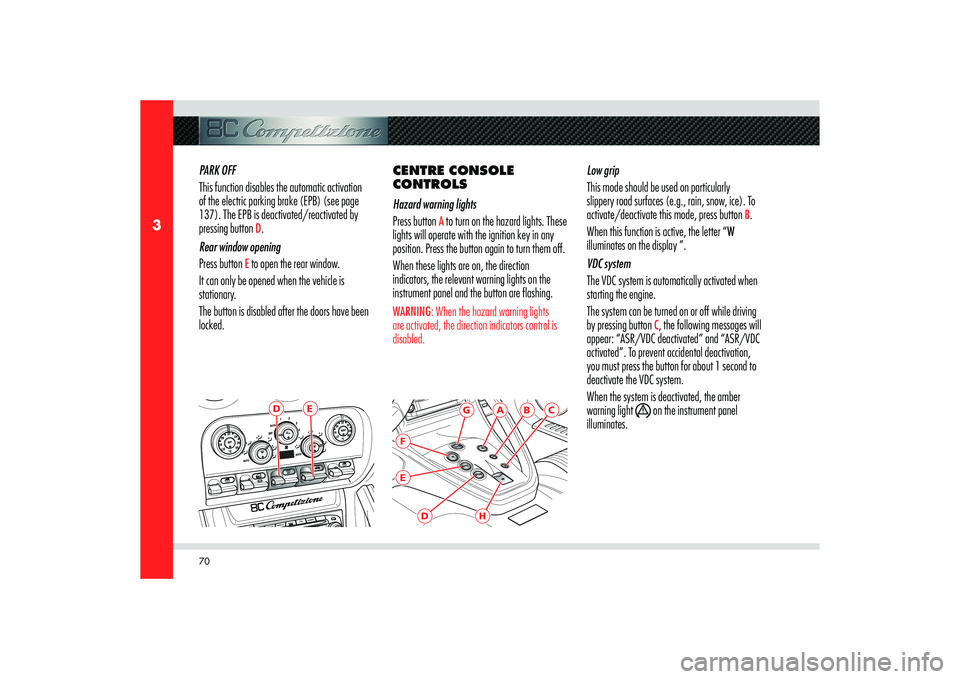
70
3
E
D
B
A
G
FE
D
H
C
PARK OFF
This function disables the automatic activation
of the electric parking brake (EPB) (see page
137). The EPB is deactivated/reactivated by
pressing button
D.
Rear window opening
Press button
E to open the rear window.
It can only be opened when the vehicle is
stationary.
The button is disabled after the doors have been
locked.CENTRE CONSOLE
CONTROLS
Hazard warning lights
Press button
A to turn on the hazard lights. These
lights will operate with the ignition key in any
position. Press the button again to turn them off.
When these lights are on, the direction
indicators, the relevant warning lights on the
instrument panel and the button are flashing.
WARNING: When the hazard warning lights
are activated, the direction indicators control is
disabled.
Low grip
This mode should be used on particularly
slippery road surfaces (e.g., rain, snow, ice). To
activate/deactivate this mode, press button
B.
When this function is active, the letter “W
illuminates on the display ”.
VDC system
The VDC system is automatically activated when
starting the engine.
The system can be turned on or off while driving
by pressing button
C, the following messages will
appear: “ASR/VDC deactivated” and “ASR/VDC
activated”. To prevent accidental deactivation,
you must press the button for about 1 second to
deactivate the VDC system.
When the system is deactivated, the amber
warning light
on the instrument panel
illuminates.
Page 80 of 223
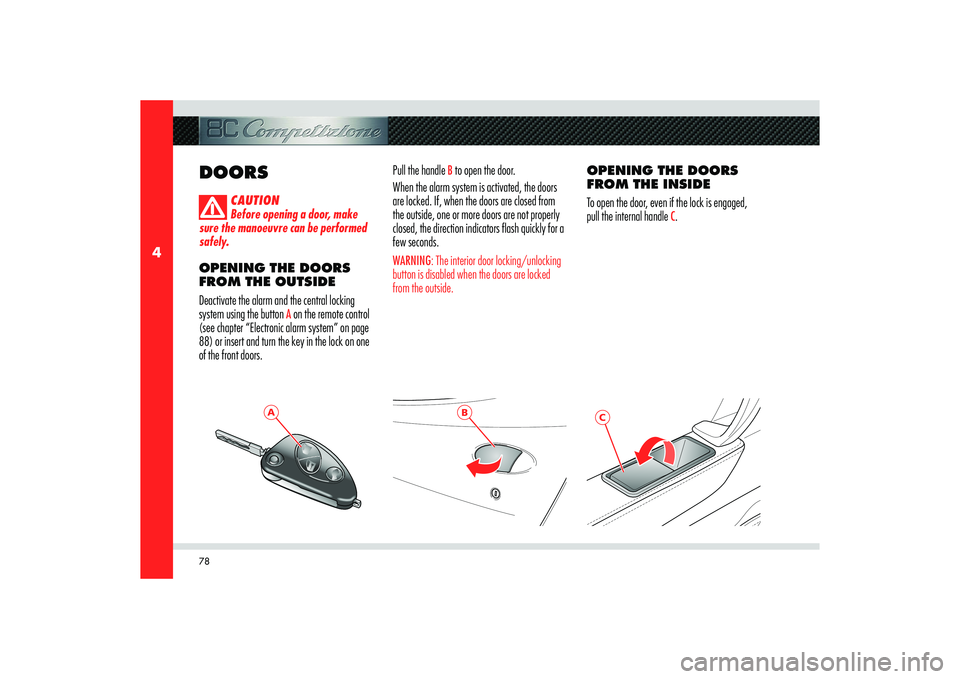
78
4
B
A
C
DOORS
CAUTION
Before opening a door, make
sure the manoeuvre can be performed
safely.
OPENING THE DOORS
FROM THE OUTSIDE
Deactivate the alarm and the central locking
system using the button
A on the remote control
(see chapter “Electronic alarm system” on page
88) or insert and turn the key in the lock on one
of the front doors. Pull the handle
B to open the door.
When the alarm system is activated, the doors
are locked. If, when the doors are closed from
the outside, one or more doors are not properly
closed, the direction indicators flash quickly for a
few seconds.
WARNING: The interior door locking/unlocking
button is disabled when the doors are locked
from the outside.
OPENING THE DOORS
FROM THE INSIDE
To open the door, even if the lock is engaged,
pull the internal handle
C.
Page 81 of 223

79
4
D
E
BEFORE YOU DRIVE
There is a button on the front central dashboard
that activates door locking and unlocking:D - door locking/unlocking.
OPEN DOOR WARNING
LIGHTS
If the doors and the engine/luggage
compartment lids are not closed properly, this is
signalled by the illumination of relative symbols
on the instrument panel display, accompanied by
the messages “Door open” or “Doors open”.DOOR LOCK ECU
INITIALISATION
Every time the battery is reconnected or a
fuse replaced, you must perform the system
initialisation procedure to ensure proper system
operation. To perform this procedure, lock and
then unlock the doors using the door remote
control.DOOR COURTESY LIGHT
Each door has a courtesy light
E fitted on the
lower part of the door panel to light up the area
where you get into and out of the vehicle.
We suggest that you move the seat fully back
before getting out of the vehicle, which also
makes it easier to get back in.
Page 83 of 223
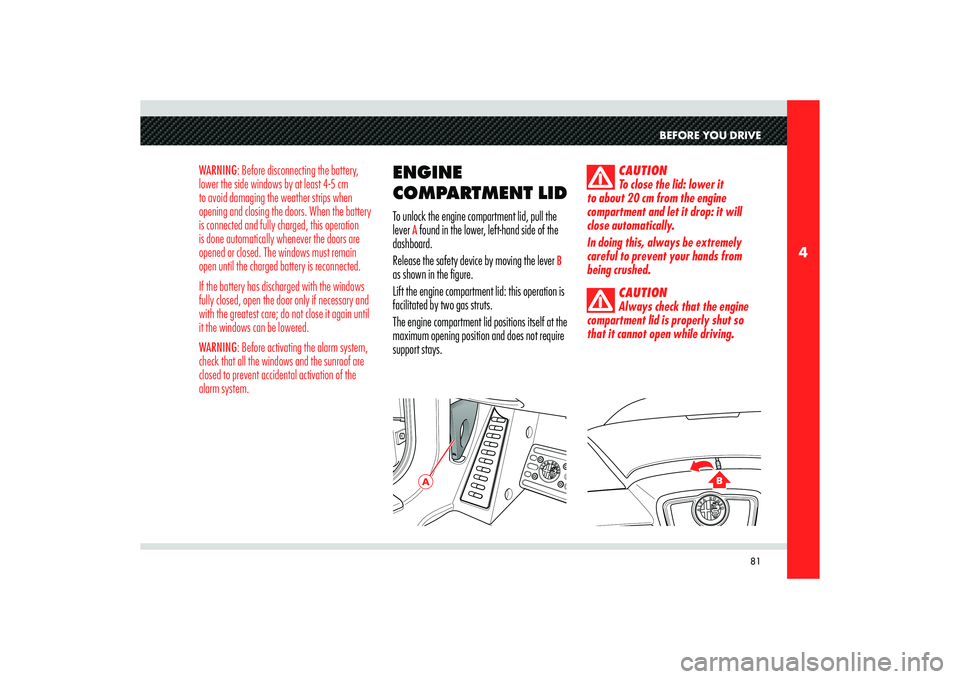
81
4
A
B
BEFORE YOU DRIVE
WARNING: Before disconnecting the battery,
lower the side windows by at least 4-5 cm
to avoid damaging the weather strips when
opening and closing the doors. When the battery
is connected and fully charged, this operation
is done automatically whenever the doors are
opened or closed. The windows must remain
open until the charged battery is reconnected.
If the battery has discharged with the windows
fully closed, open the door only if necessary and
with the greatest care; do not close it again until
it the windows can be lowered.
WARNING: Before activating the alarm system,
check that all the windows and the sunroof are
closed to prevent accidental activation of the
alarm system.
ENGINE
COMPARTMENT LID
To unlock the engine compartment lid, pull the
lever
A found in the lower, left-hand side of the
dashboard.
Release the safety device by moving the lever
B
as shown in the figure.
Lift the engine compartment lid: this operation is
facilitated by two gas struts.
The engine compartment lid positions itself at the
maximum opening position and does not require
support stays.
CAUTION
To close the lid: lower it
to about 20 cm from the engine
compartment and let it drop: it will
close automatically.
In doing this, always be extremely
careful to prevent your hands from
being crushed.
CAUTION
Always check that the engine
compartment lid is properly shut so
that it cannot open while driving.
Page 84 of 223
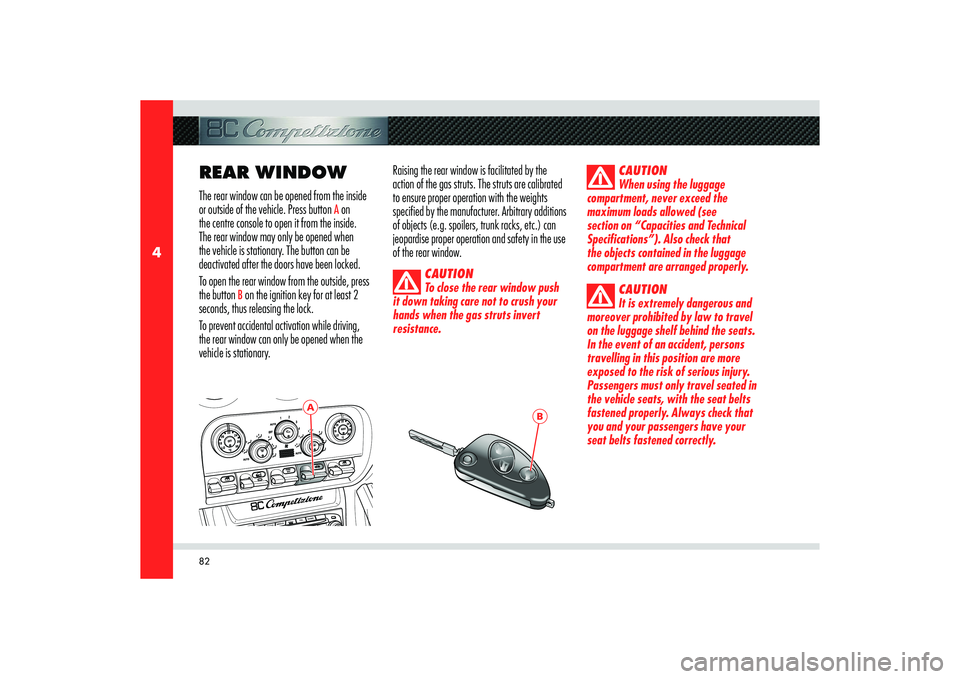
82
4
A
B
REAR WINDOWThe rear window can be opened from the inside
or outside of the vehicle. Press button
A on
the centre console to open it from the inside.
The rear window may only be opened when
the vehicle is stationary. The button can be
deactivated after the doors have been locked.
To open the rear window from the outside, press
the button
B on the ignition key for at least 2
seconds, thus releasing the lock.
To prevent accidental activation while driving,
the rear window can only be opened when the
vehicle is stationary.Raising the rear window is facilitated by the
action of the gas struts. The struts are calibrated
to ensure proper operation with the weights
specified by the manufacturer. Arbitrary additions
of objects (e.g. spoilers, trunk racks, etc.) can
jeopardise proper operation and safety in the use
of the rear window.
CAUTION
To close the rear window push
it down taking care not to crush your
hands when the gas struts invert
resistance.
CAUTION
When using the luggage
compartment, never exceed the
maximum loads allowed (see
section on “Capacities and Technical
Specifications”). Also check that
the objects contained in the luggage
compartment are arranged properly.
CAUTION
It is extremely dangerous and
moreover prohibited by law to travel
on the luggage shelf behind the seats.
In the event of an accident, persons
travelling in this position are more
exposed to the risk of serious injury.
Passengers must only travel seated in
the vehicle seats, with the seat belts
fastened properly. Always check that
you and your passengers have your
seat belts fastened correctly.
Page 85 of 223
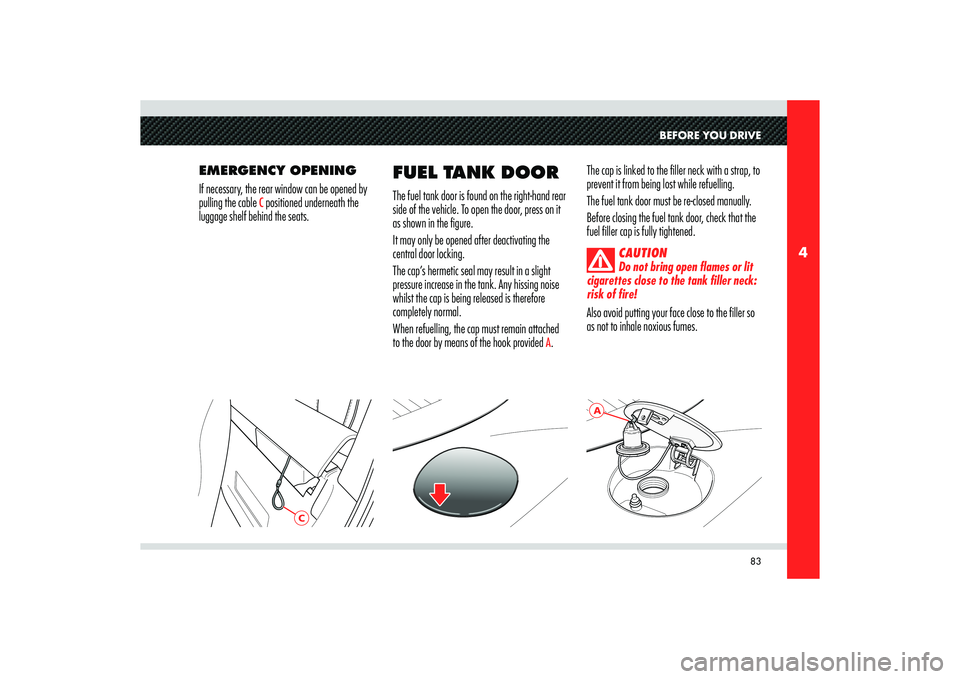
83
4
A
C
BEFORE YOU DRIVE
EMERGENCY OPENING
If necessary, the rear window can be opened by
pulling the cable
C positioned underneath the
luggage shelf behind the seats.The cap is linked to the filler neck with a strap, to
prevent it from being lost while refuelling.
The fuel tank door must be re-closed manually.
Before closing the fuel tank door, check that the
fuel filler cap is fully tightened.
CAUTION
Do not bring open flames or lit
cigarettes close to the tank filler neck:
risk of fire!
Also avoid putting your face close to the filler so
as not to inhale noxious fumes.
FUEL TANK DOOR The fuel tank door is found on the right-hand rear
side of the vehicle. To open the door, press on it
as shown in the figure.
It may only be opened after deactivating the
central door locking.
The cap’s hermetic seal may result in a slight
pressure increase in the tank. Any hissing noise
whilst the cap is being released is therefore
completely normal.
When refuelling, the cap must remain attached
to the door by means of the hook provided
A.
Page 86 of 223
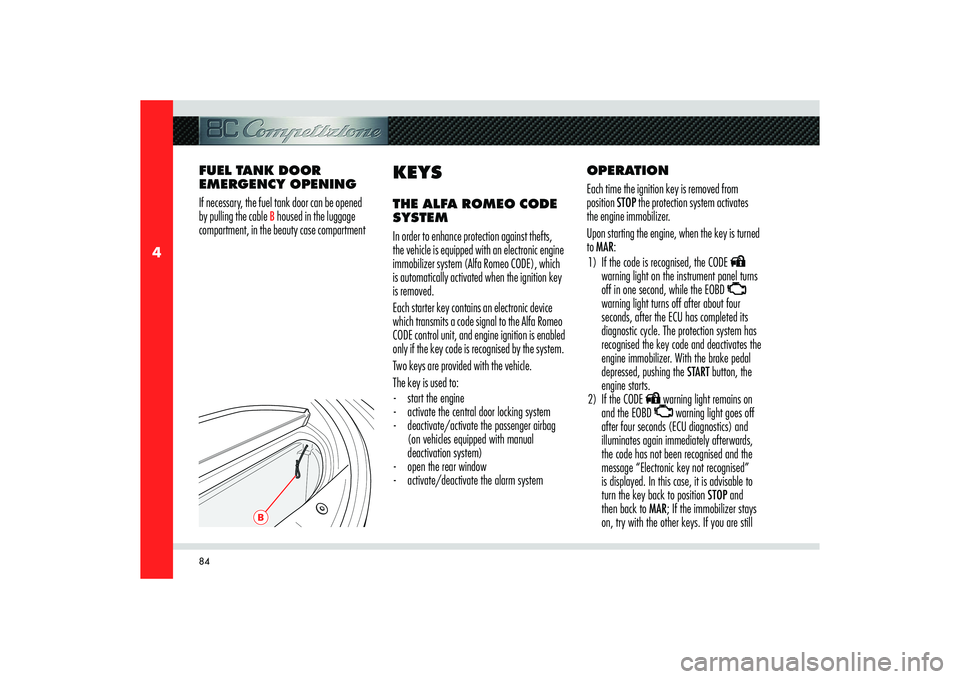
84
4
B
OPERATION
Each time the ignition key is removed from
position STOP the protection system activates
the engine immobilizer.
Upon starting the engine, when the key is turned
to MAR:
1) If the code is recognised, the CODE
warning light on the instrument panel turns
off in one second, while the EOBD
warning light turns off after about four
seconds, after the ECU has completed its
diagnostic cycle. The protection system has
recognised the key code and deactivates the
engine immobilizer. With the brake pedal
depressed, pushing the START button, the
engine starts.
2) If the CODE warning light remains on
and the EOBD warning light goes off
after four seconds (ECU diagnostics) and
illuminates again immediately afterwards,
the code has not been recognised and the
message “Electronic key not recognised”
is displayed. In this case, it is advisable to
turn the key back to position STOP and
then back to MAR; If the immobilizer stays
on, try with the other keys. If you are still FUEL TANK DOOR
EMERGENCY OPENING
If necessary, the fuel tank door can be opened
by pulling the cable
B housed in the luggage
compartment, in the beauty case compartment
KEYSTHE ALFA ROMEO CODE
SYSTEM
In order to enhance protection against thefts,
the vehicle is equipped with an electronic engine
immobilizer system (Alfa Romeo CODE), which
is automatically activated when the ignition key
is removed.
Each starter key contains an electronic device
which transmits a code signal to the Alfa Romeo
CODE control unit, and engine ignition is enabled
only if the key code is recognised by the system.
Two keys are provided with the vehicle.
The key is used to:
- start the engine
- activate the central door locking system
- deactivate/activate the passenger airbag
(on vehicles equipped with manual
deactivation system)
- open the rear window
- activate/deactivate the alarm system
Page 89 of 223
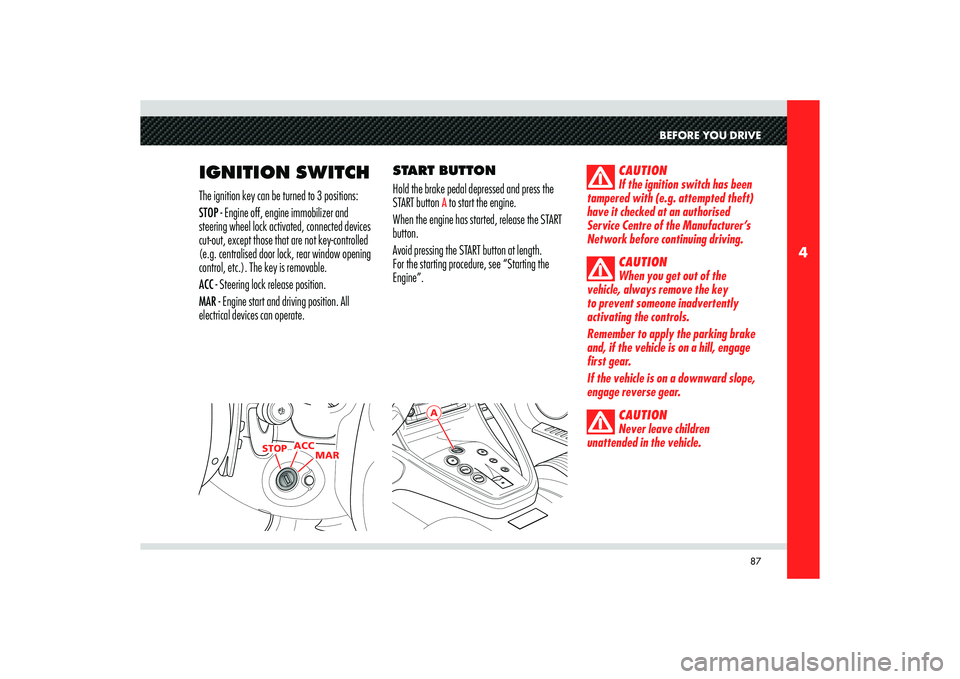
87
4
STOPACC
MAR
A
BEFORE YOU DRIVE
IGNITION SWITCHThe ignition key can be turned to 3 positions:
STOP - Engine off, engine immobilizer and
steering wheel lock activated, connected devices
cut-out, except those that are not key-controlled
(e.g. centralised door lock, rear window opening
control, etc.). The key is removable.
ACC - Steering lock release position.
MAR - Engine start and driving position. All
electrical devices can operate.START BUTTON
Hold the brake pedal depressed and press the
START button
A to start the engine.
When the engine has started, release the START
button.
Avoid pressing the START button at length.
For the starting procedure, see “Starting the
Engine”.
CAUTION
If the ignition switch has been
tampered with (e.g. attempted theft)
have it checked at an authorised
Service Centre of the Manufacturer’s
Network before continuing driving.
CAUTION
When you get out of the
vehicle, always remove the key
to prevent someone inadvertently
activating the controls.
Remember to apply the parking brake
and, if the vehicle is on a hill, engage
first gear.
If the vehicle is on a downward slope,
engage reverse gear.
CAUTION
Never leave children
unattended in the vehicle.